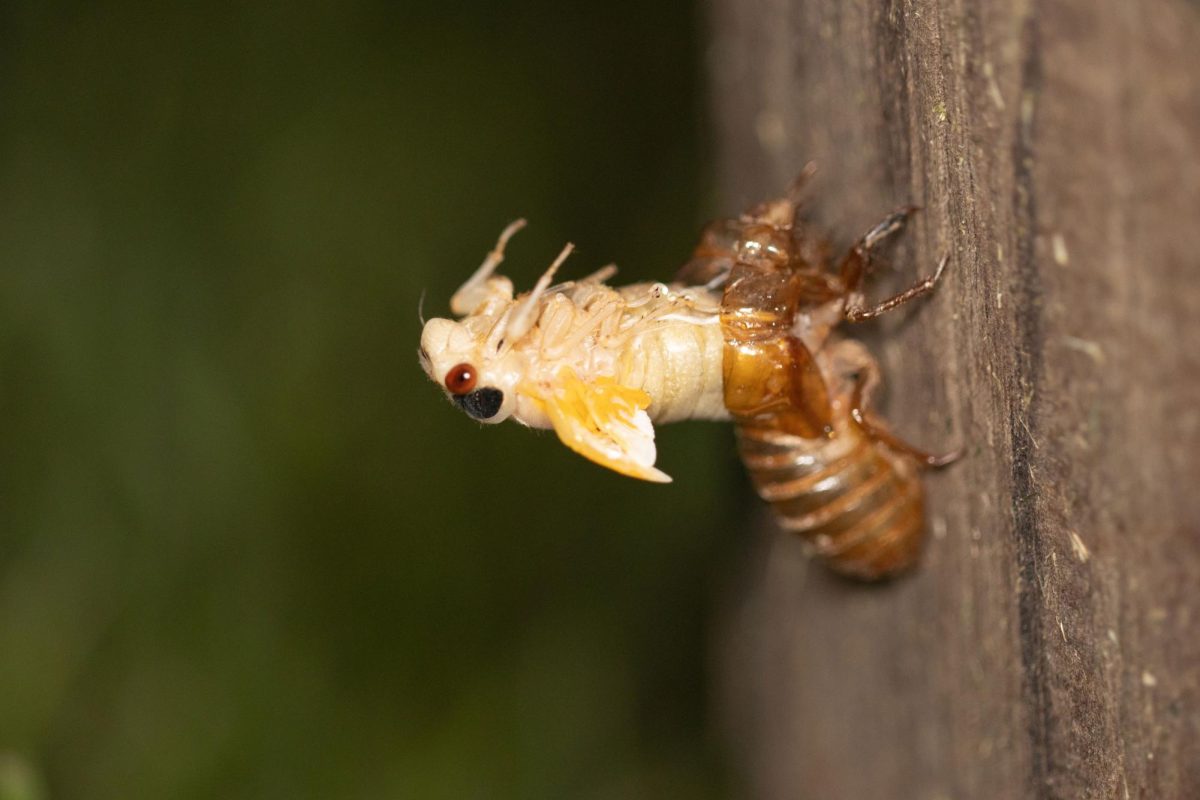Researchers found the mass arrival of cicadas in 2021 in the mid-Atlantic and Midwest regions of the United States caused cascading effects on local food webs in a study co-authored by a Columbian College of Arts & Sciences professor published earlier this month.
The study found that during the cicadas’ emergence in May 2021, more than 80 species of birds in Maryland switched their diets to cicadas — large bugs that emerge from the ground for four to six weeks once every 13 or 17 years to avoid predators. Co-author John Lill, a professor of biology, said the dietary shift caused an “explosion” in the numbers of caterpillars in Maryland because birds consumed fewer of them, which in turn increased caterpillars’ consumption of trees.
“Birds from very small to incredibly large, of all different guilds, birds that are normally feeding on, scavenging dead animals or feeding on fruits or feeding on seeds all switched and started eating cicadas, which was kind of surprising,” Lill said.
Lill said researchers from GW, Georgetown University and the University of Maryland planted fake clay caterpillars on trees and recorded damage from birds’ beaks on the clay to understand bird predation patterns. He said researchers compared the damage from the beaks over three years starting in 2020 — one emergence year in 2021, when cicadas emerge from underground, and two control years, 2020 and 2022.
Lill said the clay caterpillars were far less damaged during the year of the cicada emergence than the two control years, allowing researchers to determine that the birds’ switch to eating cicadas significantly decrease avian predation on caterpillars during emergence years.
“As soon as the cicadas started coming out, the birds started ignoring our fake caterpillars. They just couldn’t be bothered,” Lill said. “That suggested that not just one species, but the whole community of insectivorous birds had shifted to eating cicadas.”
Lill said researchers published the article shortly before next year’s historic emergence in the Midwest of two separate broods of cicadas — Brood XIX, which emerges every 13 years, and Brood XIII, which emerges every 17 years. He said he will next study the impacts of cicadas in Illinois, where the two broods will emerge.
“A 13 and 17 year are simultaneously emerging throughout the state of Illinois,” Lill said. “So we’re going to be in Chicago and around that area to observe that phenomenon. Because 13 and 17 are both prime numbers, multiply those two numbers together, and you get 221, and that’s how often that happens. They co-occur every 221 years, so the last time this happened was 1803. I don’t think Chicago was even founded in 1803.”
Martha Weiss, a co-author and a professor of biology at Georgetown, said cicada emergences are major resource pulses — unusually large emergences of an energy source in an ecosystem’s food web — and can occur periodically or randomly.
Experts in food web ecology said the study highlighted the link between cicada emergences and caterpillar population levels in deciduous North American forests, which feature trees that lose their leaves each winter and are the natural habitat of cicadas.
Chris Whelan, an evolutionary ecologist and a professor of biological sciences at the University of Illinois Chicago, said the study’s finding that there is greater tree consumption when there is less bird predation falls in line with some of his past research. He said excluding birds led to an increase in the population of caterpillars, which led to a jump in the consumption of trees.
“What we found was that when you exclude the birds, when you compare the herbivory to the control where the birds are present, I think it was as much as a 30 percent increase in herbivory. So by excluding birds, the white oaks were experiencing greater herbivory,” Whelan said.
Robert Marquis, a professor emeritus of biology at the University of Missouri-St. Louis, said the study adds to scientific literature on species’ interactions with each other and bolsters knowledge about how changes in some species’ populations have greater consequences than others, like cicadas’ impact on caterpillars.
“From a conservation standpoint, this is really important because you could potentially have the collapse of a system or loss of a lot of species if there’s one link that for some reason becomes weakened or strengthened for whatever reason, maybe due to climate change. And so here we have a link that we didn’t really know about until Dr. Weiss and Dr. Lill did their experiments,” Marquis said.
Walt Koenig, a graduate professor at Cornell University and a research zoologist emeritus at the University of California, Berkeley, said the researchers did not test an “obvious” alternative hypothesis for why birds ate fewer caterpillars during the cicada emergence — that there may have been fewer birds in the area. Koenig said he published a paper that found birds are less abundant during cicada emergences.
He said the study didn’t address the possibility of a population decline among birds despite both hypotheses having the same effect on increased herbivory, or plant consumption, from caterpillars. Koenig said that he and his colleague, will be writing a letter to Science, the journal that published the study, to raise their concern. He said the researchers made an error but still have much to be proud of.
“Whether they have it or not, I don’t know. But they didn’t raise the issue, they didn’t cite our papers and they didn’t even mention it as an alternative hypothesis,” Koenig said. “In order to actually demonstrate and support their hypothesis, they would have to show that the birds are actually eating cicadas as opposed to eating the forest insects that are not getting eaten.”
Lill said researchers did consider the alternative hypothesis of fewer birds being present, but the data they collected is not consistent with the alternative hypothesis because they observed “dramatic” variation in response variables, like beak marks in the clay caterpillars within the emergence year. He said their study did not measure bird abundance but instead focused on the change in diet of the birds that are present.
Louie Yang, a professor of entomology and nematology at the University of California, Davis, said the study was “fantastic” and that the researchers faced a difficult task when they set out to collect the data featured in their paper because the nature of cicada emergences only gave them one chance to collect high-quality data.
“One of the things that was most impressive was the long-term monitoring of predation risk over three years using plasticine caterpillar models,” Yang said. “That requires a kind of foresight and persistence and determination to keep monitoring.”





